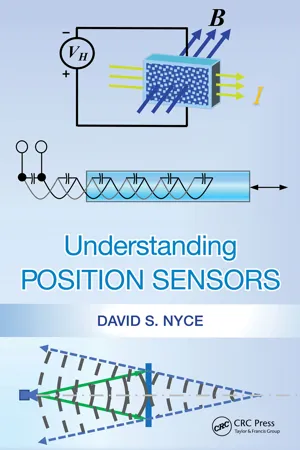Physics
Optical Encoder
An optical encoder is a device that converts motion or position into a series of digital signals using light. It typically consists of a light source, a patterned disc, and a sensor to detect the light patterns. As the disc rotates, the sensor detects the changes in light patterns, allowing the encoder to determine the position or motion of the object it is attached to.
Written by Perlego with AI-assistance
5 Key excerpts on "Optical Encoder"
- Hubert Razik(Author)
- 2013(Publication Date)
- Wiley-ISTE(Publisher)
Let us approach the measurement aspect of the angular position of a mechanical shaft, then its rotation speed. For this, two categories of coders exist: one is optical and the other is electromagnetic.1.1. Optical Encoder
Different types of optical coders exist. Certain ones have many advantages and others fewer, along with the inherent constraints of the choice of technology used. For this reason, we will first cover the measurement of the absolute position and second the measurement of the relative position of the mechanical shaft.1.1.1. Technical aspect
What is an Optical Encoder?An Optical Encoder is a system that allows us to provide logic level transitions 1 and 0 depending on the mechanical rotation. It consists of a disc with cuts similar to a multitude of lines that allow light to pass though. In this way a beam of light will excite a receiver, which will provide either level 1, or level 0 transitions after transformation of the collected signals. Figure 1.2 is a synoptic diagram of an Optical Encoder where we can discern the disc itself with it axis of revolution, light emitter, receiver and space letting the beam of light pass through.The Optical Encoder is free of restraints, since mechanical disturbances interfere with its lifespan and its performance. For this reason overspeeds are not allowed, since this will destroy the cuttings as well as causing mechanical vibrations that will vibrate the disc, bringing it into involuntary contact with the receiver or the emitter. In both cases, the defect encountered is irreversible since the cutting is affected by an anomaly. Before mentioning some of the defects of encoders, let us now look at the different types of Optical Encoders, starting with the absolute encoder.Figure 1.2.Representative diagram of an Optical Encoder1.1.2. Absolute encoder
The advantage of this encoder is to provide precise information of the angular position since, during the operation of the sensor, it is the real position of the shaft that is provided. Nevertheless, for problems of cutting quality, only the Gray code is recommended. In fact, there is one and only one transition of logic state: 0 to 1 or 1 to 0. This is not the case for classic binary code. For the purposes of structural comparison, Figure 1.3(a) shows the said relative absolute encoder and Figure 1.3(b) the Gray encoder. The angular representation is given in Table 1.1- eBook - ePub
Smart Sensors and MEMS
Intelligent Sensing Devices and Microsystems for Industrial Applications
- S Nihtianov, A. Luque(Authors)
- 2018(Publication Date)
- Woodhead Publishing(Publisher)
Schellekens et al., 1986 ). In some applications, compensation of the refractive index variations is sufficient, and a wavelength tracker can be used. This tracker usually consists of an extra interferometer measurement with a mechanically stable path length (generally constructed of a low expansion material), which is representative for the nominal measurement length.10.4. Optical Encoders
The existing linear encoders encompass various detection techniques, based on brush, magnetic, inductive, capacitive, and optical principle. Optical Encoders are popular because of their noncontact, high-resolution measurement characteristics and because their output signal is easily converted into an electronic position or displacement signal. The range of applications of Optical Encoders spans from measurement of angular or linear motion in low-cost consumer products (such as computer mice and inkjet printers) to advanced industrial systems (such as machine tools, robots, and stage positioning in lithographic projection tools). An Optical Encoder contains a detection system that can detect light emanating from a patterned movable member. The patterned member is usually referred to as the “optical scale.” For a linear encoder, the scale typically contains one or more sets of parallel lines with a predetermined constant or varying pitch. Rotary encoders, also known as “shaft encoders,” have radial patterns. The detected light is converted into an electrical signal and may be processed as digital square waves or as analog signals, where analog signals allow for resolution enhancement by means of interpolation.There are two types of Optical Encoders: absolute position and incremental displacement encoders. Most common absolute position encoders use gray-coded or pseudorandom coded scales, or scales with subsets of scales with a different pitch (see Fig. 10.17 ).The absolute encoders can be used in both linear and rotary configurations. Gray-coded scales have parallel measurement channels for measuring the bits of the gray-coded position information. A pseudorandom coded scale has a unique single track stripe pattern for each absolute position. This unique stripe pattern is read by a line camera and decoded by a microprocessor (Gribble and Robert, 2011 ). Absolute encoders may be obtained by the combination of phase information of two or more incremental encoders, which have a different pitch and are integrated on the same scale. In the example in Fig. 10.17(c) , the phase differences between the measured phases provide coarse absolute position information, which is refined by the interpolated phase of one of the phase quadrature signals. Absolute scales with different pitches are also available as hybrid scales where the coarse absolute position is derived from subsets of capacitance-based scale signals, which are then refined by the signal from a fine pitch incremental optical scale (Mitutoyo Catalog, 2016 - eBook - ePub
Sensor Systems
Fundamentals and Applications
- Clarence W. de Silva(Author)
- 2016(Publication Date)
- CRC Press(Publisher)
The other three approaches may be used in special circumstances, where the optical method may not be suitable (e.g., under extreme temperatures or in the presence of dust, smoke) or may be redundant (e.g., where a code disk such as a toothed wheel is already available as an integral part of the moving member). For a given type of encoder (incremental or absolute), the method of signal interpretation is identical for all four types of signal generation listed previously. Now, we briefly describe the principle of signal generation for all four techniques and consider only the Optical Encoder in the context of signal interpretation and processing. 11.2.1.1.1 Optical Encoder The Optical Encoder uses an opaque disk (code disk) that has one or more circular tracks, with some pattern (sequence) of identical transparent windows (slits) in each track. A parallel beam of light (e.g., from a set of light-emitting diodes [LEDs]) is projected to all tracks from one side of the disk. The transmitted light is picked off using a bank of photosensors on the other side of the disk, which typically has one photosensor for each track. This arrangement is shown in Figure 11.2a, which indicates just one track and one pickoff sensor. The light sensor could be a silicon photodiode or a phototransistor (see Chapter 10). Since the light from the source is interrupted by the opaque regions of the track, the output signal from the photosensor is a series of voltage pulses. This signal can be interpreted (e.g., through edge detection or level detection) to obtain the increments in the angular position and also the angular velocity of the disk. In standard terminology, the sensor element of such a measuring device is the encoder disk, which is connected to the rotating object (directly or through a gear mechanism) - eBook - ePub
- Paul P.L. Regtien, Edwin Dertien(Authors)
- 2018(Publication Date)
- Elsevier(Publisher)
The optical sensors described in this section are digital in nature. They convert, through an optical intermediate, the measurement quantity into a binary signal, representing a binary coded measurement value. Sensor types that belong to this category are Optical Encoders, designed for measuring linear and angular displacement, optical tachometers (measuring angular speed or the number of revolutions per unit of time) and optical bar code systems for identification purposes.Optical Encoders are composed of a light source, a light sensor and a coding device (much the same as the general setup in Fig. 7.1 ). The coding device consists of a flat strip for linear displacement or disk for angular displacement, containing a pattern of alternating opaque and transparent segments (the transmission mode) or alternating reflective and absorbing segments (the reflection mode). Both cases are illustrated in Fig. 7.12 .Figure 7.12 Optical Encoders in (A) transmission mode and (B) reflection mode.The coding device can move relatively to the assembly of transmitter and receiver causing the radiant transfer between them switch between a high and a low value. In the transmission mode the encoder consists either of a translucent material (e.g., glass, plastic, and mylar), covered with a pattern of an opaque material (for instance a metallization), or just the reverse, for instance a metal plate with slots or holes.Two basic encoder types are distinguished: absolute and incremental encoders. An absolute encoder gives instantaneous information about the absolute displacement or the angular position. Fig. 7.13 gives examples of absolute encoder devices in transmission mode.Figure 7.13 Absolute encoders: (A) linear encoders with 4-bit dual code and with 4-bit gray code, (B) readout system with collimator, and (C) angular encoder disc.Each (discrete) position corresponds to a unique code, which is obtained by an optical readout system that is basically a multiple version of Fig. 7.12A . The acquisition of absolute position with a resolution of n bits requires at least n optical tracks on the encoder and n - eBook - ePub
- David Nyce(Author)
- 2023(Publication Date)
- CRC Press(Publisher)
13 EncodersDOI: 10.1201/9781003368991-1313.1 Linear and Rotary
Linear and rotary position or displacement can be measured and communicated by a device called an encoder without using any form of analog-to-digital (A/D) conversion, because the basic output signal is already in a digital format. Although the term encoder has also been applied to devices based on Moiré patterns from diffraction gratings, as well as laser interferometers, the terms encoder, linear encoder, and rotary encoder will be used here in reference to standard industrial sensors based on geometric patterns applied along a linear, angular, or circular scale and detected by any one of several methods. Encoders are available as incremental or absolute reading, and encompass various detection techniques, including brush-type, optical, magnetic, and capacitive types. The most common detection methods for industrial encoders are magnetic and optical. Besides selecting whether the output will be absolute or incremental, encoder designers make trade-offs among important product features, including ruggedness, resolution, physical size, and cost.13.2 History of Encoders
The earliest type of encoder was the brush-type, a linear version of which is depicted in Figure 13.1 . In the figure, flexible mechanical contact fingers rub along a metal pattern printed onto an insulating base. The path of the brush moves over conducting and insulating segments. The conductor pattern is formed onto the base in the same way as printed circuit boards are made for connecting electronic circuits.The figure shows a straight binary code. An alternative, the Gray code, is explained later in this chapter. In the figure, the brush holder and four brushes (flexible metallic contact brushes) move along a left-to-right measuring axis. Dark segments represent the electrically conductive areas that would normally be connected to a positive voltage, such as +3.3 or +5 volts DC, to represent a logic one. Light areas are insulated or not electrically connected, and represent a logic zero. So, when a brush is on a light area, the signal from that brush is at logic zero (zero volts), and when a brush is on a dark area, the signal from that brush is at logic one (+3.3 or +5 volts). The brush holder shown is an insulating material, so wires can be connected with each brush to bring their voltages to a measurement or readout circuit. With the brushes in their rightmost position as shown, all four are at logic one, and indicate binary 1111, or decimal 15 (or hexadecimal F). At the leftmost position, binary 0000, or decimal 0 would be indicated. As the brushes move to the right from zero, the indicated position increments by 1 for each new position. These positions can be called digital positions zero through fifteen, or numeral positions one through sixteen. This simple pictorial, having only 4 bits, is shown for simplicity. Normal encoders will usually have at least eight, and up to 18 bits. Eight bits can indicate positions 0 through 255, for a resolution of about 0.4% (that is 100% × 1/256), while 18 bits can indicate 0 through 262,143 (note: 218
Index pages curate the most relevant extracts from our library of academic textbooks. They’ve been created using an in-house natural language model (NLM), each adding context and meaning to key research topics.
Explore more topic indexes
Explore more topic indexes
1 of 6
Explore more topic indexes
1 of 4




